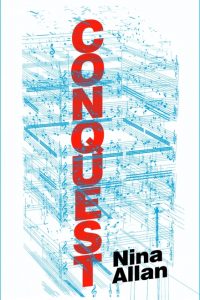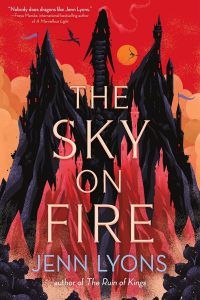Gary K. Wolfe reviews Greg Egan
 Egan’s Clockwork Rocket, the first volume of a trilogy collectively titled Orthogonal, begins with an almost textbook example of SFnal estrangement: ‘‘When Yalda was almost three years old, she was entrusted with the task of bearing her grandfather into the forest to convalesce.’’ Immediately we surmise that there’s something unusual about this three-year-old, or perhaps about what a ‘‘year’’ means, and this is further complicated by the revelation that her grandfather’s malady is a ‘‘serious light deficiency’’ and that he needs a ‘‘broader spectrum of illumination’’ than what is provided by local crops, or even by sunlight. Yalda and her family, we learn, live in a universe in which light travels at different speeds according to its wavelength – stars appear as streaks as the different colors reach the observer – and in which even vegetation emits energy in the form of light. Further, Yalda’s people have the capacity to reform their own bodies, extruding limbs as needed; shifting weight and musculature to different parts of the body, even displaying notes and diagrams by raising ridges on their chests. Childbirth is especially traumatic: almost everyone is born with a ‘‘co-stead’’ – thus the oddly twin-paired names like Lucio and Lucia or Claudio and Claudia – and children are born through the sacrifice of the mother’s body (in one of the rare deliberate echoes of our own society, a drug which helps prevent women from spontaneously giving birth is a topic of some social controversy).Learning the nature of her world from her father and grandfather, Yalda proves to be an adept and brilliant student whose pointed questions are pretty much the same ones the reader is asking in these opening chapters. We meet her again, now 12 years old, at university where, inspired by a lecture on optics by a brilliant scientist named Eusebio, she becomes fascinated by the nature of light, energy, and their relationship. By describing an alternate-physics version of the double-slit experiment, Eusebio clues us in to what we’re in for during the next several chapters – which is essentially Yalda’s rediscovery, in her own -orld’s terms, of many of the principles of modern physics, including the wave-particle duality, spectral analysis, the relationship of time and space, even the invention of the camera. Egan isn’t alone in recreating the birth of scientific investigation in a completely invented context – Ted Chiang did something similar in ‘‘Exhalation’’, and Neal Stephenson approached it in Anathem – but neither of them offered the obsessive degree of detail – all those charts – and the determination to fully explicate his hypothetical frame of reference. Time in this world is measured in flickers, chimes, lapses, stints, and pauses, and space in scants, strolls, saunters, and separations. The entire world of Yalda is maintained rigorously at the level of a disciplined thought experiment, and for many readers these chapters involving Yalda’s education and growing reputation as a scientist may be more than a bit challenging (though Egan offers helpful guides in an afterword and on his website). More worrisome for some might be the broader question – since we know we’re in for a trilogy – is the question of when the actual crisis plot is going to kick in, or whether this entire first volume might actually be an extended entrance exam.
Egan’s Clockwork Rocket, the first volume of a trilogy collectively titled Orthogonal, begins with an almost textbook example of SFnal estrangement: ‘‘When Yalda was almost three years old, she was entrusted with the task of bearing her grandfather into the forest to convalesce.’’ Immediately we surmise that there’s something unusual about this three-year-old, or perhaps about what a ‘‘year’’ means, and this is further complicated by the revelation that her grandfather’s malady is a ‘‘serious light deficiency’’ and that he needs a ‘‘broader spectrum of illumination’’ than what is provided by local crops, or even by sunlight. Yalda and her family, we learn, live in a universe in which light travels at different speeds according to its wavelength – stars appear as streaks as the different colors reach the observer – and in which even vegetation emits energy in the form of light. Further, Yalda’s people have the capacity to reform their own bodies, extruding limbs as needed; shifting weight and musculature to different parts of the body, even displaying notes and diagrams by raising ridges on their chests. Childbirth is especially traumatic: almost everyone is born with a ‘‘co-stead’’ – thus the oddly twin-paired names like Lucio and Lucia or Claudio and Claudia – and children are born through the sacrifice of the mother’s body (in one of the rare deliberate echoes of our own society, a drug which helps prevent women from spontaneously giving birth is a topic of some social controversy).Learning the nature of her world from her father and grandfather, Yalda proves to be an adept and brilliant student whose pointed questions are pretty much the same ones the reader is asking in these opening chapters. We meet her again, now 12 years old, at university where, inspired by a lecture on optics by a brilliant scientist named Eusebio, she becomes fascinated by the nature of light, energy, and their relationship. By describing an alternate-physics version of the double-slit experiment, Eusebio clues us in to what we’re in for during the next several chapters – which is essentially Yalda’s rediscovery, in her own -orld’s terms, of many of the principles of modern physics, including the wave-particle duality, spectral analysis, the relationship of time and space, even the invention of the camera. Egan isn’t alone in recreating the birth of scientific investigation in a completely invented context – Ted Chiang did something similar in ‘‘Exhalation’’, and Neal Stephenson approached it in Anathem – but neither of them offered the obsessive degree of detail – all those charts – and the determination to fully explicate his hypothetical frame of reference. Time in this world is measured in flickers, chimes, lapses, stints, and pauses, and space in scants, strolls, saunters, and separations. The entire world of Yalda is maintained rigorously at the level of a disciplined thought experiment, and for many readers these chapters involving Yalda’s education and growing reputation as a scientist may be more than a bit challenging (though Egan offers helpful guides in an afterword and on his website). More worrisome for some might be the broader question – since we know we’re in for a trilogy – is the question of when the actual crisis plot is going to kick in, or whether this entire first volume might actually be an extended entrance exam.
Fortunately, the plot kicks in fairly soon. First as a child and later as a university student, Yalda witnesses spectacular meteor-like displays called Hurtlers, and eventually realizes that these explosive phenomena are growing more common, increasing the chances of a direct collision with the planet, a global catastrophe that has already happened to a neighboring planet (the most useful of the diagrams explains the problem quite neatly). But Yalda – by now a distinguished lecturer and tutor – recognizes that her society’s science is far too undeveloped to invent a means of protection from the Hurtlers, and with the aid of a wealthy patron she hatches what, in the language of thrillers, is usually referred to as a desperate scheme: given the inverted relativity of this universe, a spaceship sent out on a circuitous route, at something like four-fifths the speed of blue light (the fastest of the wavelengths), could return in only a few years – but generations would have passed aboard the ship, during which time the ship’s inhabitants may have had time to develop the advanced science needed to protect against the Hurtlers. Suddenly we are back in more familiar SF territory, although transformed through Egan’s imaginary physics – the construction of a giant rocket (which in fact is an entire mountain, recalling images like Blish’s spindizzies from Cities in Flight), the problems of adjusting to zero gravity (and related issues like how to raise wheat in space), the dangers of performing extravehicular repairs, challenges to Yalda’s leadership – in fact, all the classic issues of the generation-starship tale, which presumably will lead us into the next two novels in the series. Though perhaps a bit late getting started, this human dimension of the tale, from Yalda’s unstated love for Eusebio (who she must leave behind) to her growing reputation as a near-visionary leader, becomes solidly compelling and even unexpectedly moving. Egan has probably done as much as any SF writer to uncover a kind of chilly Euclidian beauty in the pure mathematics of space-time, but he can still surprise us with the comparatively far simpler story of a girl who became a hero.








